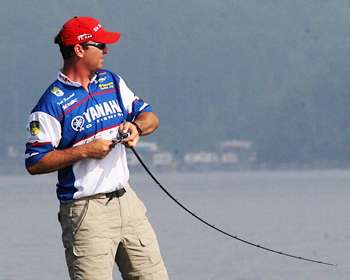
Growing up on Texas' famed Sam Rayburn Reservoir, Elite Series pro Todd Faircloth was privy to essentially every big bass tactic that came down the pike. From dragging big worms to running deep diving crankbaits, Faircloth will admit there's not much in the way of fishing techniques his Texas upbringing didn't foster.
Just like Faircloth, the technique known as "burning a 'Trap" is as Texan as it comes. The technique — which refers to speed reeling a lipless crankbait, like a Rat-L-Trap — will produce anywhere, particularly at two key times in the year.
"Predominantly, burning a 'Trap is going to be relegated to prespawn," Faircloth explains. "When you get into the fall and the water starts cooling back down, it can be really hot as well. So, primarily, you're looking at two windows — early spring and fall — where this technique really shines. The water temperatures are cooler, and the fish are looking for something that's moving pretty fast."
Faircloth reveals the real key to this technique is to reel the bait as fast as you can, keeping it right on top of the grass. "My best days have been when I'm sitting in 3 to 5 feet of water," he says. "You want to make long casts and be ready for the rod to load up immediately. For some reason, most of my bigger bites come on the very end of a long cast."
Faircloth points out the rod plays an important role in being able to keep the bait "ticking" the top of the grass. "It's important to keep your rod tip high and the bait coming toward you," he explains. "If you lose contact with the grass, lower your rod tip as the bait comes closer to the boat."
A high-speed 7:1 ratio reel is Faircloth's preferred choice, though he will drop down to a slower 6:1 ratio if he's fishing deeper grass. "You need that high-speed reel to move the bait along at the right speed," he says. "Also, your line choice is very important. Three-fourths of the time I'll use fluorocarbon line, and the rest of the time I'll use braid. Those two lines have less stretch than monofilament, and you need a line that doesn't have a lot of stretch. Almost every time your strikes will come when you're ripping it free from the grass."
Faircloth explains that he generally favors a bait that makes a lot of noise over one that doesn't; however, he looks at water clarity and the mood of the fish to drive the final decision of color and noise. "I always keep a red Rat-L-Trap tied on during prespawn, and a chrome or shad-patterned 'Trap in the fall," he says.
At times, bass seem reluctant to react to a noisy lure, so Faircloth switches to a lipless bait that doesn't contain rattles, like a Sebile Flatt Shad, and continues to catch bass.
The chief complaint among novice anglers attempting to "burn a 'Trap" is that the bait regularly gets fouled with grass. Faircloth admits this is a challenge, but he cautions against simply throwing in the towel. "You're always going to get grass on your bait, there's just no way around that," he says.
"It's like anything else, the more often you fish it, the better you get. A lot of people get tired of all the work involved in ripping and burning a 'Trap, but it's worth the effort."
Faircloth points out there are a variety of baits that an angler can use during the prespawn and fall seasons that will produce both size and numbers, but few give the constant action that a lipless crankbait will. For that reason, he says this bait and technique are a natural fit to get new anglers attracted to the sport.
"A lipless crankbait is a lure anyone can go out there and catch fish on," Faircloth says. "It's an easy technique to learn, and it's one where there's always a lot of action because you're moving the bait so fast. It's a really good technique to use when you're introducing a kid to fishing."




